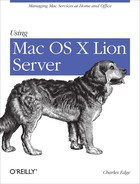Deployment is the process for automating the configuration of new computers into a known state. Imaging is the process of placing an image on a computer, such as what Apple does prior to shipping new computers.
Deployment includes pushing an image to a client computer in a full fashion, a process known as monolithic imaging. But deployment can also mean a package-based workflow where you push out a minimal image and then lay automations on top of that image. Lion Server is an integral part of any imaging workflow.
In this chapter, we are looking primarily at the imaging aspect of deployment, appropriate for many small environments including homes and small offices. Lion is the first operating system from Apple deployed solely on the Internet. No more optical or USB media from Apple to install computers. This means that if you have a slow Internet connection that it can take a considerable amount of time to install new computers.
An example would be if you have 10 computers that you want to install from scratch. Each has to download the entire operating system over the Internet independently. Each also has to be configured to work on the network, log into the server and maybe have a few pieces of software installed as well. This entire process can take up to two hours per system. However, if you have an image that you have prepared, you can probably do all 10 computers within 20 minutes or less, with the systems completely configured and a perfect uniform configuration between them.
Imaging is a process where a client computer boots to a disk and performs a data restoration to another disk. You cannot image a drive that you are booted to, as doing so would mean erasing your boot volume. Therefore, when imaging Mac OS X client computers, you need to boot to one place and image another. This can mean rebooting your computer through Target Disk Mode and then using a program such as Carbon Copy Cloner to clone files, or a logical set of files in a bundle known as an image, to the computers. This can also meaning to a boot volume hosted on a network using Apple’s NetBoot technology.
NetBoot is a tool for booting from an image on a server. Once booted, Apple has two options for deployment. The first is known as NetInstall, which performs an installation on client systems, along with a number of automations customized to that system. The second is known as NetRestore, which takes an image and restores it to a volume in its entirety. All three require the development of images, done using a tool called System Image Utility, available in the /Applications/Server directory of a computer that has had the Server Admin Tools installed (for more on installing the Server Admin Tools for Lion Server, see Chapter 2).
Note
In this chapter, we look at using Lion Server as a NetBoot server; however, there are third-party tools for performing such an operation.
When imaging there are a number of automations that need to occur to the data imaged in order to have that system be unique. In this chapter, we look at using a few different tools to make systems unique, including Disk Utility. However, it is worth noting that not all imaging tools actually make the system unique (e.g., SuperDuper!), as many are built for backup, not mature solutions for imaging multiple systems.
